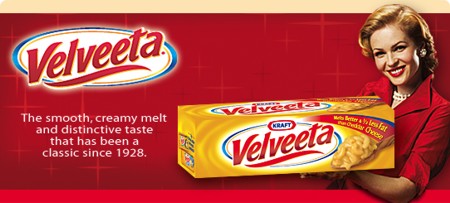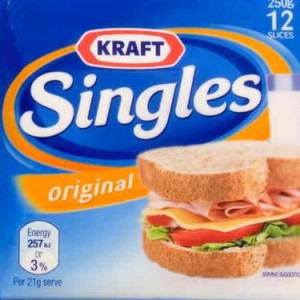We’ve heard repeatedly that young diners are demanding fresher, more natural foods these days. Now, a look at the statistics shows that an iconic baby Boomer’s staple – ‘American’ Cheese – is on the verge of extinction as a result of changing tastes. It doesn’t take a genius to figure out why…
 Velveeta Processed Cheese product, ‘a classic since 1928’.
Velveeta Processed Cheese product, ‘a classic since 1928’.
This package art, circa 1965, captures perfectly the
place that ‘American’ Cheese has occupied in the hearts
of millions of families from the 1920s through the 1990s.
‘American’ Cheese is not all that it seems. In fact, it’s not really natural Cheese at all. The rest of the world (outside the U.S.) calls the stuff by its rightful name: Processed Cheese (‘Food’ or ‘Product’). Though invented in 1911 by a Swiss entrepreneur named Walter Gerber, it gets the ‘American’ moniker because American food magnate J.L. Kraft brought it to the U.S. and patented the method by which it is manufactured in 1916. Kraft went on the make the stuff famous.
Today, ‘American’ Cheese may consist of trim scraps and substandard Cheeses of many kinds, though most often Cheddar and Colby are used. They are cooked with Water, Milk Solids, Vegetable Starches, Saturated Vegetable Oils, Annatto (Orange Cheese Colouring), preservatives and emulsifiers (to prevent separation) to produce a product that is uniform in flavour and colour and has exceptional stability, shelf life and ‘meltability’ – the ability to melt without separating into pools of Oil and clumps of Milk Solids.
Why so popular?
Kraft made his first fortune by selling ‘American’ Cheese to the U.S. Army to be included with field rations. Multitudes of American soldiers got hooked on it during the First World War and continued to eat it after they came home. Then came the Second World War, and tinned American Cheese was again a field ration staple. Again, soldiers developed a definite taste for the stuff and passed it on to their offspring, the Baby Boomers. After the Boomers, the Gen-Xers took up Processed Cheese almost as a cult craving using it in every application they could come up with.
But Processed, or ‘American’, Cheese came into its heyday – and achieved its lasting fame – as the ultimate slice to top a Burger during the Dawn of he Burger Age in the 1950s, as well as the rage for Macaroni and Cheese that arose around the same time. Nothing else melted like it. More recently, ‘American’ Cheese has become the key ingredient (sometimes the only one) in the ubiquitous ‘Cheese’ Sauces we find on Nachos and many other dishes, again because of its unique meltability.
The beginning of the end?
But now – since 2000 – tastes are changing and young people growing into adulthood, where they are making their own choices about Food, are demanding more variety and higher quality in all things edible, especially Cheese. The result is a boom for specialty cheese Makers and the opening of thousands of new, artisanal Cheese factories across North America. On the flip side, sales of Kraft Singles, the leading ‘American’ Cheese product in the market, are Flat, even with a ‘test kitchen’ tram of 30 working daily to come up with new recipes and applications for the stuff. Overall, ‘American’ Cheese sales are dropping by around 1.5 percent per year.
The trend (fad?) at some restaurants to ‘go retro’ and use more old fashioned ingredients such as ‘American’ Cheese is relatively strong, but not nearly enough to turn the industry around. As a result of declining demand, prices for ‘American’ Cheese have dropped steadily since reaching a high of just under (US)$5 per lb. / (US)$11 per kilo in early 2015 to a low of just under (US)$4 per lb. / (US)$9 per kilo today.
My take…
Professional cooks look down on ‘American’ Cheese as an abomination. They’ve always made Cheese Sauces using the Mornay method: Melting, grated Cheddar or other suitable Cheese into a light Béchamel or ‘White’ Sauce. I make Mornay a lot, and always use it in my Mac and Cheese and Scalloped Cheese.
And while some insist that no natural Cheese can match the meltability of ‘American’ Cheese on a Burger or Melt, I have to disagree. Just try a slice of real Cheddar, Jack, Gouda, or other, similar, Cheese. There’s no comparison. Unless you look at the price, which is one factor where ‘American’ has a distinct advantage.
But for the average family cook or casual snacker, the convenience and consistency of ‘American’ or Process Cheese can’t be beat. And there are still enough Boomers and X-ers around, who grew up on the stuff, to maintain ‘American’ Cheese as a (US)$2.77 billion per year business. For now.
~ Maggie J.

